El Bierzo - The Spanish Switzerland
Saturday, February 1, 2025
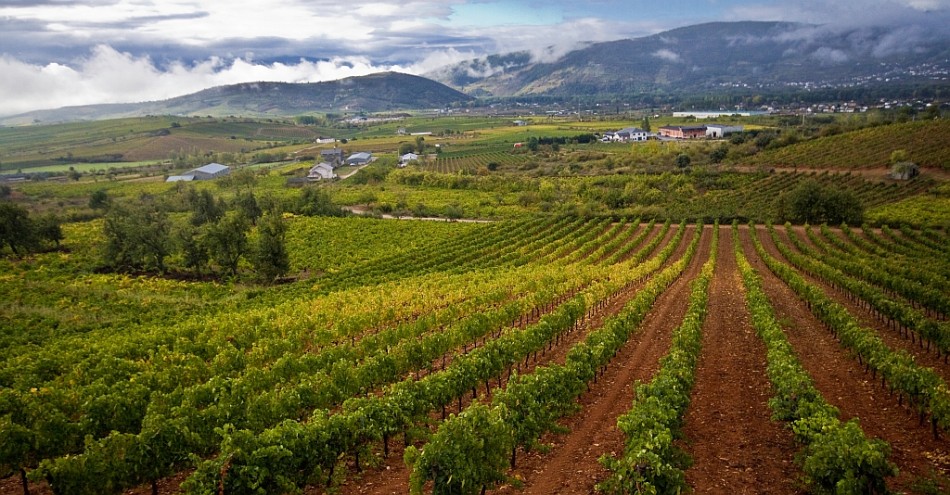
El Bierzo, located in the North-West of Spain, is a mountainous region crossed by the Road to Santiago (Way of Saint James) which the pilgrims used to call the “Spanish Switzerland”. This extreme mountain feature is what makes it, together with its climate and soil, one of the ideal regions worldwide to grow vineyards.
The Mencía grape is the main variety of El Bierzo. This variety, scorned until very recently, has managed in the last few years to seduce the best enologists and wine producers in Spain, who have slowly gone looking for it in their territory, even highlighting it as one of the Spanish varietal jewels. They have understood it contains enormous potential and the challenge of bringing out all the possibilities it conceals to make great wines with character. Wines full of subtleties, with a good aging capability, and deep expressiveness of the history-laden terroir they grow in.
The origin of Mencía is lost in time, but there are many signs indicating it could be one of the first grape stocks introduced in the Iberian Peninsula. Already in ancient times, the areas where Mencía now rules were famous for the coming and going of Roman legions which planted the first vines and built presses, and since then these areas have had a deep wine-producing tradition. Supposedly through the Roman Road, the wine produced in these lands was transported to Imperial Rome, to be enjoyed by the emperors. References to the vines of the region of El Bierzo and Valdeorras already appeared two thousand years ago cited by the Roman Pliny. With the fall of the Empire, the vines also declined.
Their rebirth and greater expansion came with the growth of medieval monasteries, for which wine was not only an element of worship, but also an essential food product. Monks introduced new growing and production techniques. In addition to the splendour of the monasteries was the brilliance of the Road to Santiago, which encouraged the spread of vines, bestowing wine with a special significance. The first pilgrims to Santiago already spoke of the excellence of the wines produced along the way. On the road, wine became a precious asset, an element of barter, to pay taxes and also to pay the saints of the area for their miracles.
At the end of the 19th century, however, the phylloxera changed the picture, destroying many of the vines and leading to a major economic crisis that forced many to emigrate. Aside from people, it meant also the loss of many native Spanish varieties, which were not recovered until very recently.
Vine growing was re-established in the first half of the 20th century, but the consequences of the Spanish Civil War between 1936 -1939 plunged many wine producers into absolute poverty, which forced them to emigrate, leading once again to the neglect of many vineyards.
Mencía generates wines of a deep raspberry colour, intense fruit aromas, but also delicate flower ones, good alcohol doses, proper acidity and aging possibility. Until recently, reds made of Mencía were rather light wines, ready to drink, with low alcohol content. Gradually they have changed, especially in El Bierzo, into wines that seek to bring out their full potential, the expressiveness of their soil, and the good aging capacity Mencía is showing, adding ever-longer aging periods in wood. This has resulted in the rebirth of this stock, which recent studies liken greatly to Cabernet Franc, which is why some link its origin to Bordeaux and the pilgrims coming from France for centuries following the Road to Santiago.
A very sensitive grape, the Mencía crop stands out predominantly in mountain regions, which is why its ripening has much to do with the sun orientation and altitude of the vineyards. El Bierzo is the Spanish designation with the most French characteristics. Its geography features major geographical contrasts, deep river basins, mountainous ranges and marked differences between its high and low lands, all of which is reflected in its wines. Mineral slate soils, but also clay-muddy ones, stand out in the territory of Mencía. The substratum marks the wine’s minerality, and also underscores the various fruit expressions and concentrations.
 1
Like
Published at 12:53 AM Comments (3)
1
Like
Published at 12:53 AM Comments (3)
Visit Spain's Costa Tropical
Saturday, January 25, 2025
All along its 100 kilometres of coast, Granada has plenty to be proud of. In this strip of welcoming beaches and pristine coves, a warm and bountiful climate reigns, one of long, sunny days, long evenings and starlit nights. Christened the Tropical Coast, exotic fruits grow here such as the chirimoya, or custard-apple, which can only flourish at southerly latitudes. Boxed in between the provinces of Málaga and Almería, Granada's coast is scattered with towers and ancient fortresses that in another age acted as sentinels in a hostile and turbulent Mediterranean, a haunt of pirates and knaves. The villages appear as tiny white specks among the high hills and rugged valleys.
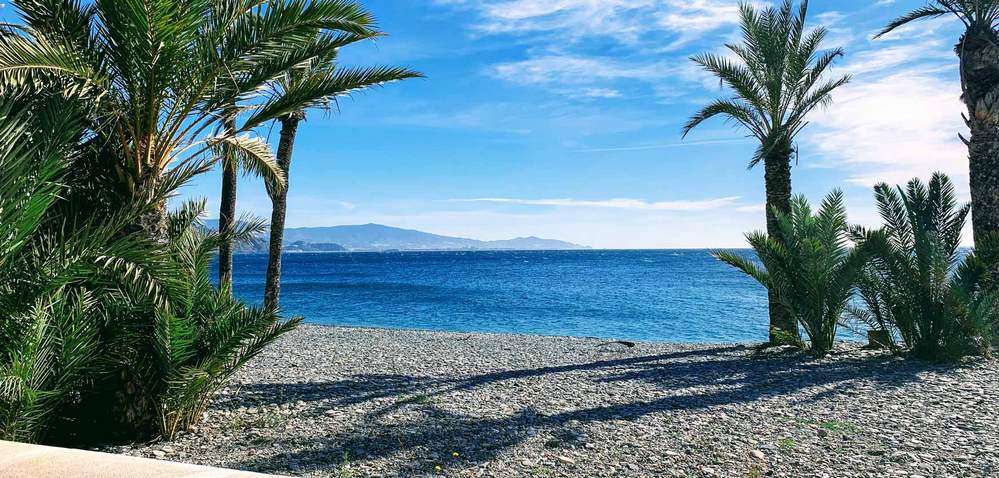
La Herradura was once a humble fishing village. Now it is a tourist centre between Cerro Gordo and Punta de la Mona. Its bay is host to naturist beaches such as Cantarriján and leisure ports such as Marina del Este, which in recent years has become a popular haven for scuba-diving enthusiasts.
The N-340 road acts as an umbilical cord between the coastal villages. From the La Herradura exit it passes curves, gradients, viewpoints and sheer ravines before arriving at Almuñécar. The oldest of the region's villages has its most identifiable postcard image in the form of the beach of San Cristóbal.
The maritime drive continues between tall, leafy palm trees. On the way lies the bronze statue of Abderramán I, the Umayyad prince who disembarked one morning in the year 755 ready to make Cordoba the capital of Muslim Andalusia. He arrived in Almuñecar, which in previous centuries had welcomed the Phoenicians, attracted by the fishing and fruit of the fertile coast. Almuñécar was crowned by an Arab castle.
The Archaeological Museum is in Cueva de los Siete Palacios. There is a bird park and footpaths leading inland towards the valley of the Río Verde, where the chirimoya plantations extend. The uphill route to the villages of Jete, Otívar and Lentegí is marked by farming cooperatives.
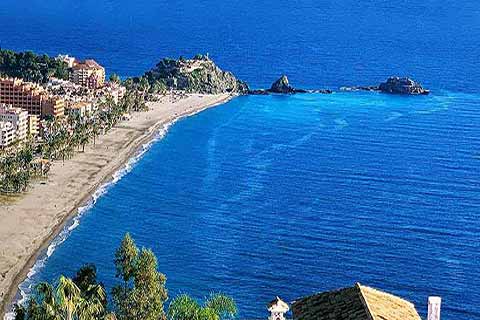
Though once woodland in which nothing grew except broom and holm oak, since the middle of the past century these valleys have been filled with medium-sized trees brought from different parts of the Americas. The three villages found in the valley of the Río Grande are small and have Morisco churches.
Salobreña is the most beautiful village on the Tropical Coast. Its houses are white, a dazzling white. It is crowned by an Arab fortress and surrounded by a tortuous, narrow network of streets. Its neighbourhoods carry the names of Albayzín, El Brocal and La Fuente. Among these towers the campanile of the Mudejar church of the Virgen del Rosario.
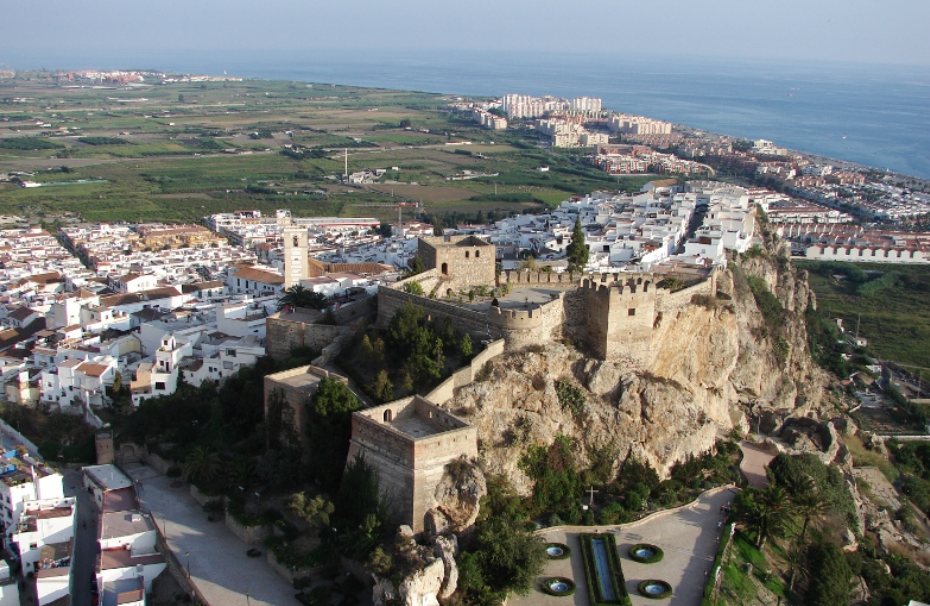
Further along you come across Motril. Granada's second most populous city lies inland, in the heart of a fertile plain surrounded by impregnable mountains. The fields of crops that reach towards the sandy line of the sea are sowed with mango, banana, avocado, chirimoya, papaya and guava.
The tree-lined avenues lead to the hill where the shrine of Nuestra Señora de la Cabeza is sited. Centuries ago, this place was the palace of retreat for the sultana Aixa, mother of Boabdil, the last Arab king of Granada. At the foot of the shrine is spread the park of the Pueblos de America. The Church of the Incarnation is Mudejar and the Casa de la Palma, an old sugar refinery of Arabic origin, is today a cultural centre.
Here ends this route, which brings together the fertility and the grandeur of the mountains, which are constantly leaning towards the sea.
Granada's Tropical Coast lies trapped between the foothills of the southern Sierra Nevada and the Mediterranean. It therefore produces a unique climate, hence the name of the coast in this area.
The star of its subtropical crops is the chirimoya or custard-apple, a green, heart-shaped fruit with ivory-white flesh, which leaves a soft, somewhat sweet taste on the palate.
The fruit is native to southern Ecuador and northern Peru; the first Spanish explorers to reach these lands were those who brought it to Europe.

The indigenous varieties of Fino de Jete and Campas are those that benefit from the status of Protected Designation of Origin.
It provides an average of 103 kcal per fruit.
20% of its weight is made up of carbohydrates in the form of sugars. Rich in calcium, vitamin C and fibre, it helps intestinal movement.
The cuisine of Granada's Tropical Coast is mostly determined by its fruit. The chirimoya, the avocado, the mango and the guava are exotic fruits that have been used to make delicious salads for some decades now. They are usually accompanied by other fruits such as kiwis, heart of palm, strawberries, pears and apples. The Tropical Coast is a pleasure to all the senses but especially sight and taste.
 3
Like
Published at 1:36 AM Comments (2)
3
Like
Published at 1:36 AM Comments (2)
Trade Routes and Piracy in the Canary Islands
Saturday, January 18, 2025
Nestled in the Atlantic Ocean, the Canary Islands have always held a special place in maritime history. Following their conquest, these islands played a pivotal role in the advent of new trade routes and significant historical events. The strategically located archipelago became a crucial link between the Old World and the New World, facilitating commerce and cultural exchange. Additionally, the islands' temperate climate provided an ideal environment for acclimating exotic plants, which boosted local agriculture and economy. However, this prosperity also attracted the attention of dreaded corsairs and pirates, making the Canary Islands a site of numerous historical confrontations.

The Strategic Importance of Canary Ports
Since the 16th century, the ports of the Canary Islands have been notably popular. What is now a haven for recreational boats and transatlantic sailboats was once a bustling hub for majestic ships embarking on lengthy voyages to the newly discovered Americas. These journeys, lasting up to eight months, required stops at the Canary Islands for essential supplies and trade, making these ports indispensable for many fleets. This era brought not only the first exotic crops and Flemish art but also the terrifying shadow of pirate fleets.
The Sugarcane Boom: A Catalyst for Economic Prosperity
The history of the Canary Islands is deeply rooted in agriculture. The indigenous barley still grown in Gran Canaria and the orchilla lichen, gathered by the earliest explorers, symbolise the islands' long-standing agricultural heritage. However, it was sugarcane that truly revolutionised the economy. Brought by the conquerors, sugarcane plantations spanned vast areas across La Palma, La Gomera, Gran Canaria, and Tenerife due to their capacity to meet the high water demands and provide ample wood for the sugar mills. These plantations flourished in large part because of the European elites' high demand for sugar, transforming the Canary Islands into a significant exporter.
The large-scale cultivation of sugarcane, however, came with a cost. Extensive deforestation and land clearances, especially in Gran Canaria, led to the near-eradication of the once-expansive Doramas Jungle. Today, only about 1% of this lush forest remains. Nevertheless, sugarcane cultivation persists, particularly in La Palma and Gran Canaria, thanks to the dedication of local farmers.
The Botanical Garden of La Orotava: Europe's First Home for Many Exotic Plants
The busy traffic of ships from the Americas allowed the Spanish Crown to amass a significant collection of exotic seeds and plants from the New World and Asia. Realising the limitations imposed by the cold European winters on these plants, King Charles III issued a Royal Decree to create the Botanical Garden of La Orotava in Tenerife in the late 18th century. Known today as the Botanical Garden of Puerto de la Cruz, this establishment is Spain's second-oldest botanical garden.
In 1788, the first coffee plants were introduced to this garden. After successfully acclimating, many were replanted in the Agaete Valley in Gran Canaria, which remains the only place in Spain still cultivating coffee. This transition further highlights the significant role of the Canary Islands in agricultural experimentation. Besides coffee, other staples like maize and potatoes found their European home in the Canary Islands, becoming essential ingredients in local cuisine. One signature dish, "papa arrugada" (wrinkled potatoes), is made from an ancient variety of potatoes that enjoys protected designation of origin status.

Pirates and Corsairs: The Dark Side of Prosperity
While trade and agriculture brought wealth to the Canary Islands, they also attracted significant threats. Pirate fleets soon set their sights on the archipelago, seeking valuable plunder. Among the infamous attackers was the Dutch corsair Pieter Van der Does, who in 1599 led a formidable fleet of 76 ships and 12,000 men that culminated in the sacking and burning of Las Palmas de Gran Canaria, then home to a mere 5,000 residents.
The archipelago also faced assaults from Berber pirates like Xabán Arrez, French pirates such as Jean Fleury and François Le Clerc (known as Peg Leg), and numerous British corsairs. To combat this menace, the Spanish Crown hired local pirates like Amaro Pargo and commissioned engineers to fortify the islands. King Philip II enlisted the Italian engineer Leonardo Torriani to assess and enhance the archipelago's defences, resulting in the construction of numerous towers and castles.
Notable fortifications include:
-
Castillo de San Miguel and Torre de San Andrés in Tenerife
-
Torre del Águila in Lanzarote
-
Castillo de Santa Catalina in La Palma
-
Torreón de San Pedro Mártir in Gran Canaria
-
Castillos de El Cotillo and Caleta de Fuste in Fuerteventura
These robust structures, many of which have survived to the present day, form a poignant testament to the islands' turbulent past during the age of piracy.
The Flemish Influence and the Dawn of Canarian Migrations
The allure of the Canary Islands reached wealthy Flemish traders, who saw tremendous opportunity in the burgeoning agricultural sector. Their influence was particularly evident in La Palma, where the arrival of Flemish settlers led to unparalleled cultural growth. Santa Cruz de La Palma, with its direct connection to Flanders, saw its churches adorned with exquisite Flemish art, some of which survives to this day.
While new settlers flowed in, many Canarians left in pursuit of opportunities in the newly discovered Americas. Pioneers from the Canary Islands helped establish cities such as Montevideo and San Antonio, Texas, contributing to the rich historical tapestry of the New World.
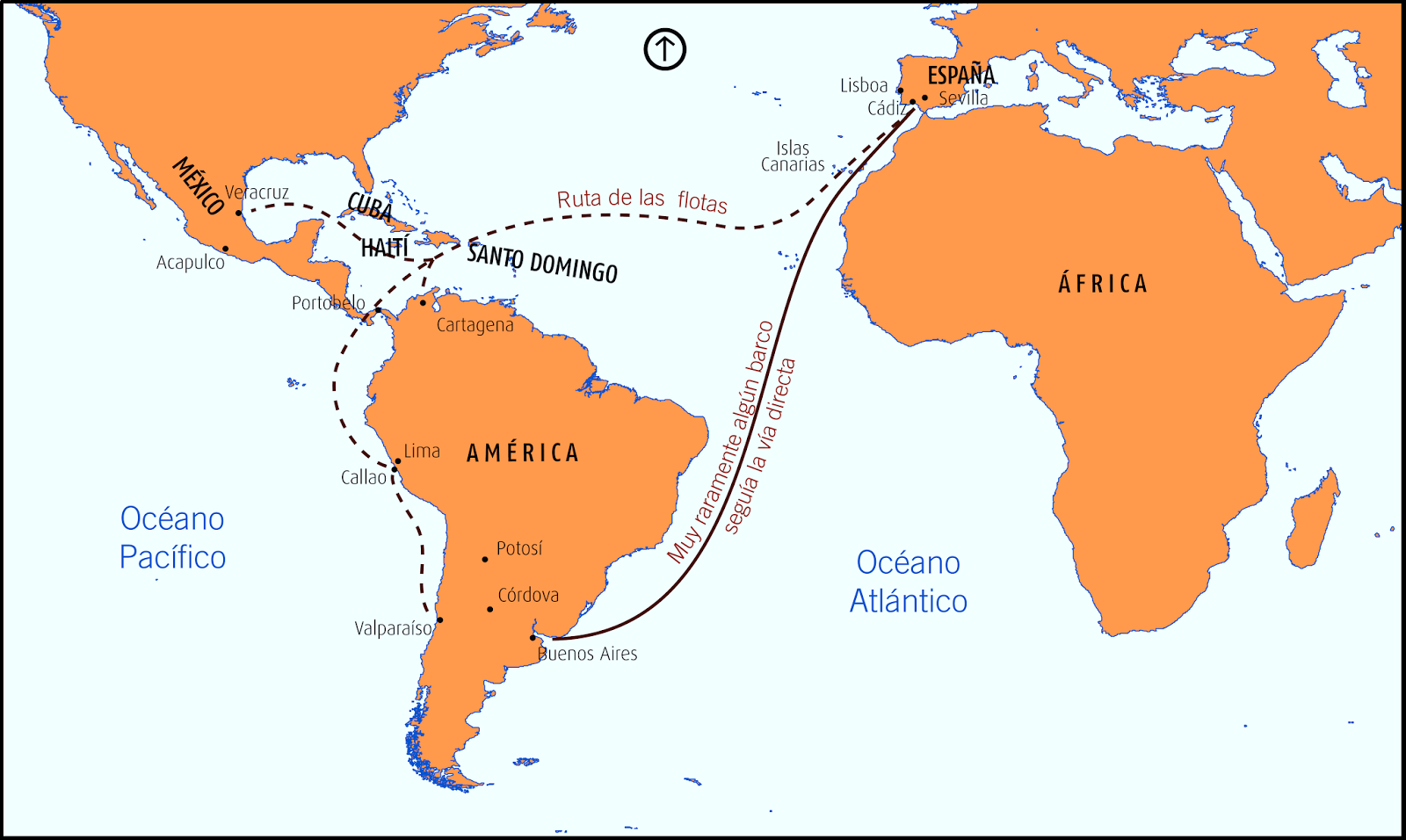
Beyond Trade Routes and Piracy: A Treasure Trove of History
Beyond trade and piracy, the Canary Islands offer a fascinating array of historical narratives. From the lifestyles of indigenous islanders to the centuries-long influence of the British, the archipelago is a treasure trove of captivating stories. Wander through the charming historic quarters, explore ancient fortresses, and savour the unique flavours of Canarian cuisine to truly appreciate the islands' diverse cultural heritage.
Whether you are drawn to the stunning beaches, the lush natural landscapes, or the intriguing historical sites, the Canary Islands promise an enriching travel experience steeped in history and tradition. So take a step back in time, and embark on a journey through the vibrant and storied past of this unique archipelago.
 2
Like
Published at 10:44 AM Comments (1)
2
Like
Published at 10:44 AM Comments (1)
Urbasa-Andia Natural Park
Friday, January 10, 2025
Millions of years ago, the relief of a great plateau known as Zunbeltz or Lizarraga changed for ever. A gigantic tectonic slip occurred that led to the opening of a wide passage between the mountain ranges of Urbasa and Andía. On the crest between Atlantic Navarre and the Mediterranean watershed, both make up an extensive Natural Park in the west of the region.
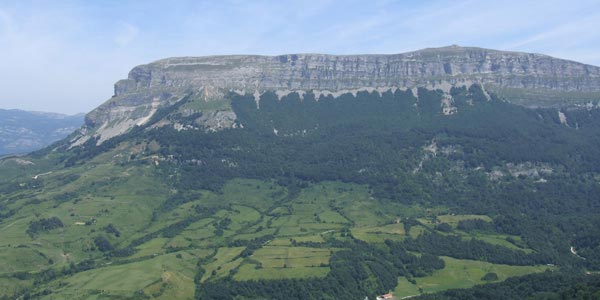
Meadows and leady beech woods alternate in this protected space with an idyllic landscape. Its southern edge falls brusquely onto the Valley of the Améscoas, forming an impressive natural viewpoint over the cirque around the source of the river Urederra.
The Information Centres contain information on this Natural Park, its leisure areas, information points, flora and fauna and signposted paths, which will take you through the beauty of woods and rock outcrops. The landscape is dotted with memories of the lifestyles over the centuries of hunters, shepherds, woodcutters and charcoal burners. The megalithic station of the Urbasa range is not signposted, so access to it is difficult.
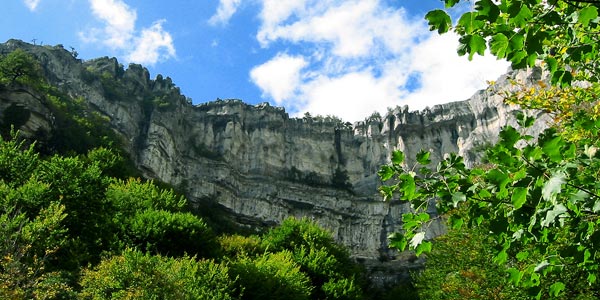
The Urbasa-Andía Natural Park in western Navarre is made up of the Urbasa and Andía mountain ranges. The NA-120 road links Etxarri-Aranatz with Estella-Lizarra and runs along the Andía range. At kilometre 20, just a few metres from the road, you will find a Roman road, a thousand-year-old witness of an era in which it connected Valdega with the Arakil valley. This range contains one of the most spectacular places in the park: the Monastery of Iranzu.
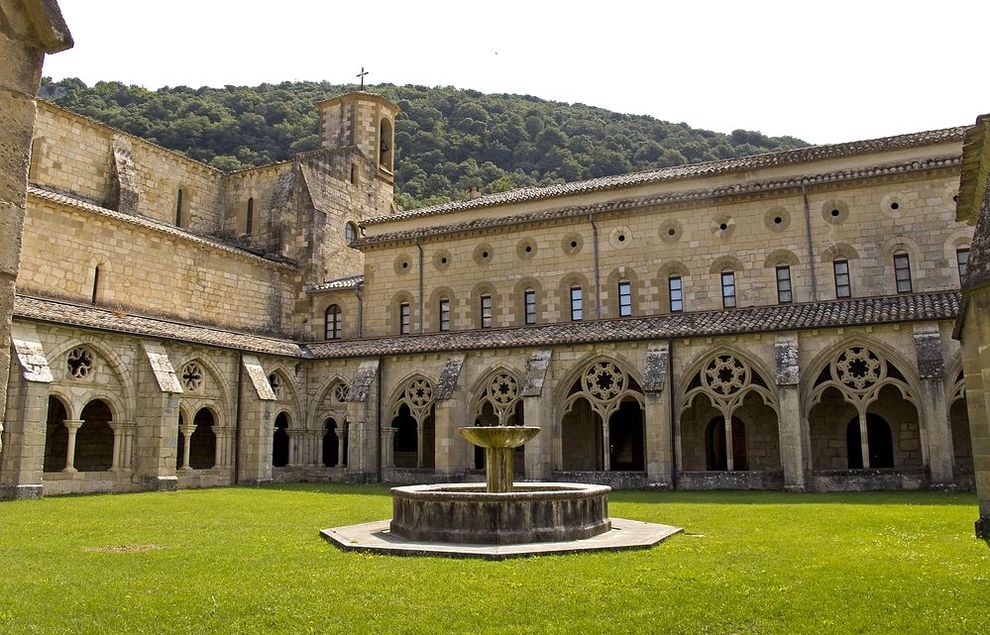
The NA-718 road from Olazti/Olazagutía to Estella-Lizarra crosses the mountain range and you can park your car at several points. It is advisable to visit the Information Centre at the north entrance, where you can find details of the landscape, environment and culture of the Natural Park. In the south, the 'Borda de Severino' - the word 'borda' is used to describe all the huts used by shepherds and livestock -, now converted into a Nature Interpretation Centre, recalls the pastoral way of life. In it a charcoal pile has been reproduced, recalling the traditional customs of the Urbasa mountain range. Several dolmens, menhirs and cromlechs are a testimony to human presence here 100,000 years ago.
The Natural Park has several viewpoints offering a full panorama of its size and resources: el Balcón de Pilatos (Pilate's Balcony - shown above), located above the cirque at the source of the river Urederra (access from the NA-718 road), the viewpoint at Lizarraga (access from the N-120) and the panoramic table next to the Palace of Urbasa (access from the NA-718).
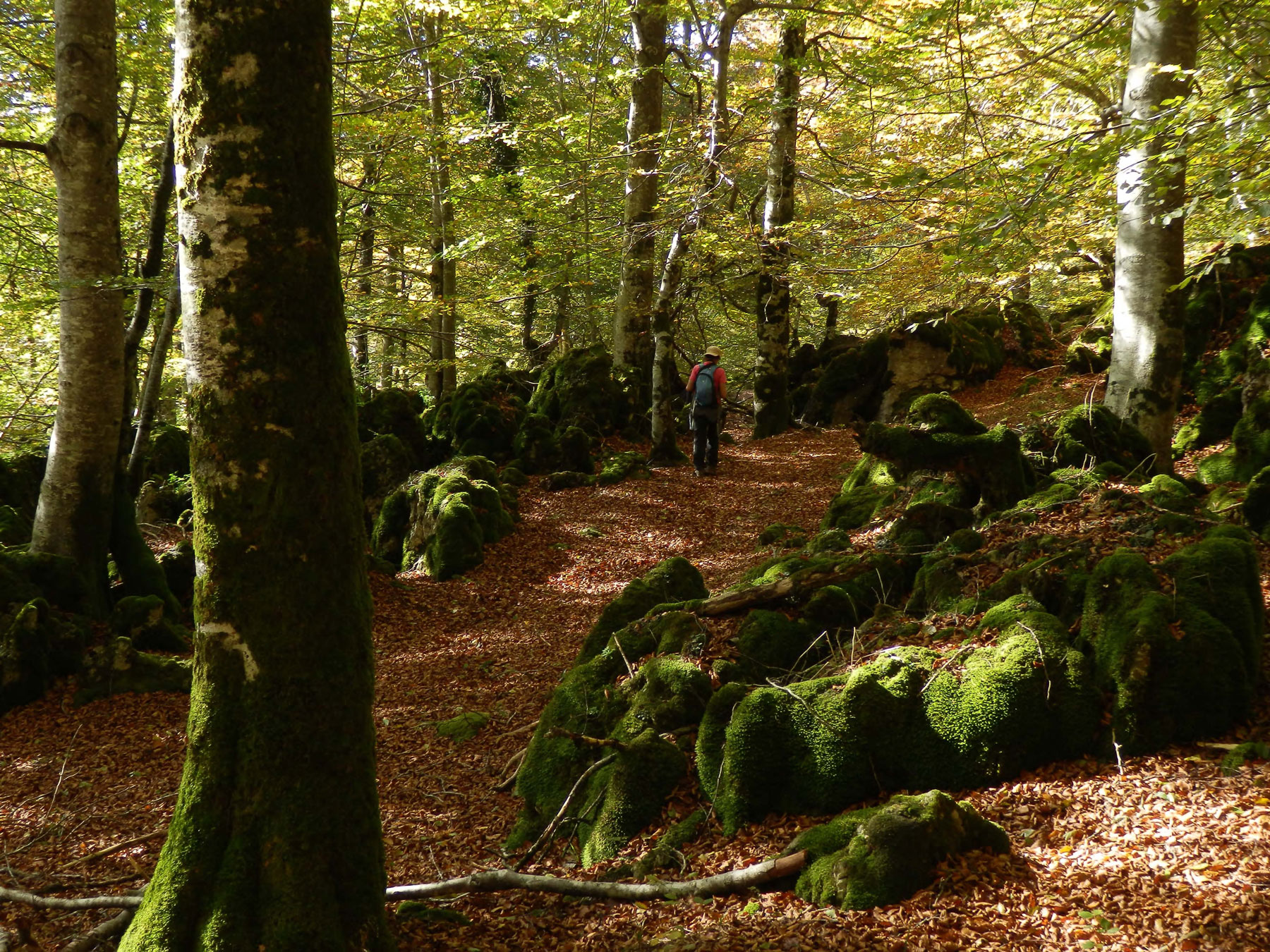
Impressive beech woods cover 70% of the territory, together with other species such as yew, juniper and pine trees. On the rasos, flat land located at around 1.000 metres above sea level, the woods give way to pastures dotted with heather and hawthorns where it is quite common to see mares and sheep grazing; the latter's milk is used to make the delicious Idiazábal cheese.
Another characteristic of this Natural Park is the absence of rivers. The limestone soil allows water to filter through and run underground in numerous chasms and crevasses, so the area is ideal for caving enthusiasts. Sometimes these underground currents emerge in the form of waterfalls. The river sources are spectacular: that of the Urederra in the Urbasa range (access from Baquedano) and of the Ubagua in the Andia range (access from Riezu). Both sites can be reached along easy paths.
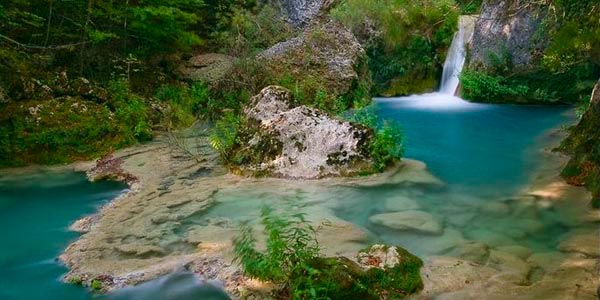
Throughout the Natural Park there are other signposted paths with different levels of difficulty that will guide you along their peculiarities. The best known are:
- The 'route of the fountains', a circular path that starts at the Borda de Severino and runs gently for 4.5 kilometres past sources/fountains and beautiful sites.
- The 'route of the shepherds', 7.6 kilometres long, is an easy path that crosses woods and rasos to give you an insight into the livestock rearing activity of Urbasa. It starts at the Information Centre and ends at the Borda de Severino.
- The 3.8-kilometre-long 'mountaineers' route', which provides access to the highest cliff in the north of the range (1,113 m.). The route is of medium difficulty, starting at the Information Centre and crossing the old Camino de la sal (salt route), which was used to transport salt from the nearby village of Salinas de Oro.
- Dulanztz and the Canyon of the Iranzu (Andía), a racket-shaped 18-kilometre-long path long that starts near the monastery of Iranzu and follows the course of the river, initially ascending through leafy woods to the summit of Dulantz.
 2
Like
Published at 3:19 AM Comments (0)
2
Like
Published at 3:19 AM Comments (0)
Celebrating Tamborrada: San Sebastián’s Rhythmic Extravaganza
Thursday, January 2, 2025
Nestled in the Basque Country in northern Spain, the coastal city of San Sebastián (Donostia in Basque) is renowned for its stunning beaches, world-class gastronomy, and vibrant culture. Among its rich array of traditions, few are as resonant and captivating as the Tamborrada. Every January 20th, San Sebastián resounds with the thunderous beats of drums, marking a festival that combines historical significance, community spirit, and unabated joy. Here’s a deep dive into the Tamborrada, a celebration like no other.
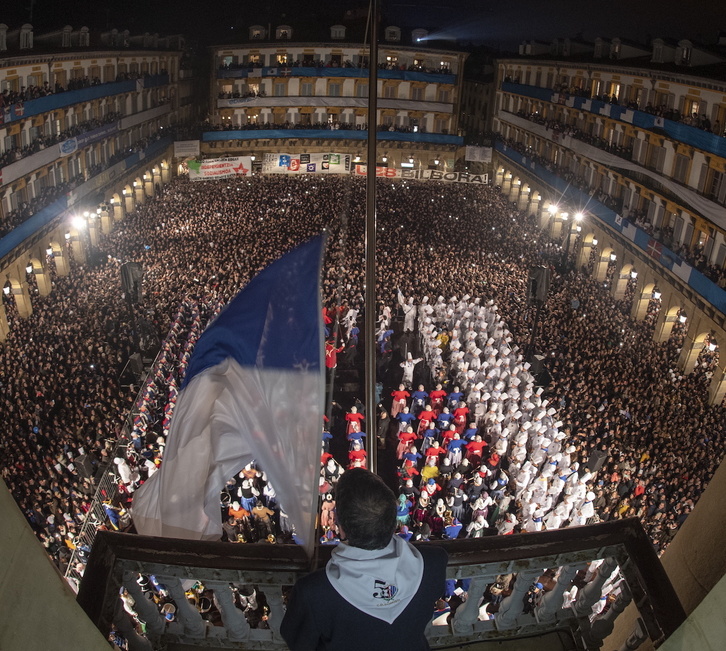
Historical Roots
The origins of the Tamborrada are a blend of legend and reality, with tales tracing back to the early 19th century during the Napoleonic wars. According to one popular story, the festival commemorates the resilience of the city’s bakers, who used drums to alert citizens when the city’s water supply was compromised by French soldiers. Another version ties the festivities to the city’s patron saint, Saint Sebastian, with marchers originally emulating the French troops who once occupied the city.
Despite its diverse narratives, the Tamborrada as it is celebrated today began to take its contemporary form in the late 19th century. The festival grew in scope and popularity over the decades, establishing itself as San Sebastián’s most vibrant and unifying event.

The Festivities
The Tamborrada kicks off precisely at midnight on January 20th in the city's Plaza de la Constitución. The event starts with the hoisting of the flag of San Sebastián, accompanied by the first drum rolls. The tradition is led by members of the Gaztelubide society, dressed in 19th-century military costumes and chef’s garb, symbolizing the baker-garnered theme of the festival.
Throughout the night and into the day, various adult and children’s drumming groups (tamborradas) parade through the streets. Participants, vibrant in historical-inspired costumes of soldiers and cooks, beat their drums and barrels with fervour, filling the air with the rhythmic pulse synonymous with the spirit of the festival.
.jpg)
-
Adult Tamborradas: Nearly 150 adult tamborradas take over the city, each with its own distinct uniform and rhythms yet unified in their spirited drumming. Bars, societies, and local organizations form these troupes, ensuring the percussion is felt in every corner of the city.
-
Children's Tamborradas: An equally cherished part of the celebration, the children's parade boasts over 7,000 youngsters from various schools in San Sebastián. These children, dressed in bright and earnest costumes, echo the heritage of the festival with their youthful energy and coordinated drumming.

Aside from the drumming, the city is alive with music played by brass bands and local choirs delivering traditional songs. The hauntingly beautiful "March of San Sebastián" and the lively "Iriyarena" are integral melodies that contribute to the festival's distinct atmosphere.
No festival in the Basque Country is complete without a feast, and the Tamborrada is no exception. Friends and families gather in gastronomic societies and homes, where they indulge in sumptuous meals featuring local specialties like bacalao a la vizcaína (cod a la Vizcayan) and merluza koskera (hake with spring vegetables). The communal meals reinforce the sense of camaraderie and shared heritage.
At its heart, the Tamborrada is a celebration of community and identity. It embodies San Sebastián’s resilience and rich cultural tapestry. The festival is not just a tradition but a living, breathing part of the city’s annual cycle, drawing together young and old, local and visitor, in a shared rhythm that resonates far beyond the one-day event.
For visitors, the Tamborrada offers a unique way to experience the vibrancy and warmth of San Sebastián. The festive atmosphere, combined with the city’s picturesque setting along the Bay of Biscay, creates an unforgettable backdrop for the celebrations. Wandering through the old town streets, savouring Basque cuisine in local taverns, and moving to the beats of countless drums forge memories that last a lifetime.
The Tamborrada of San Sebastián is more than a festival; it’s a testament to the city’s resilient spirit, cultural richness, and communal warmth. It’s a day where the past harmonizes with the present, where every beat of the drum echoes centuries of tradition and collective pride. Whether you’re a local proudly marching with your tamborrada or a visitor captivated by the spectacle, the Tamborrada leaves an indelible mark on anyone lucky enough to experience its rhythmic magic.
So, mark your calendars, pack your warmest attire, and prepare to be swept up in the heady, vibrant celebration that is the Tamborrada.
 0
Like
Published at 1:57 PM Comments (0)
0
Like
Published at 1:57 PM Comments (0)
Spam post or Abuse? Please let us know
|
|